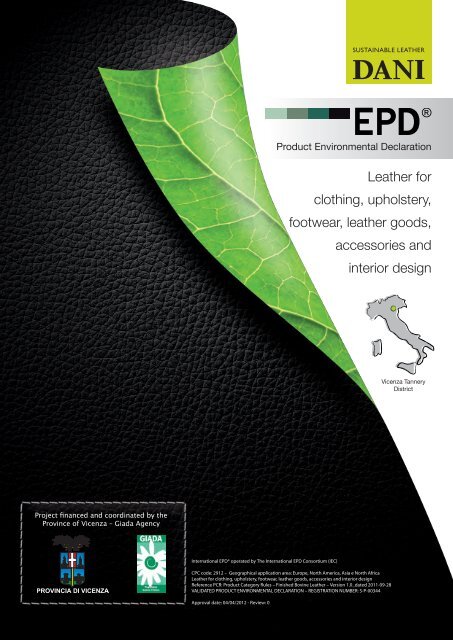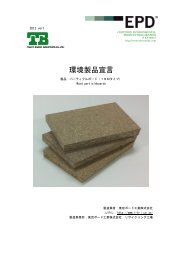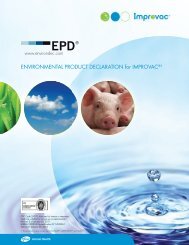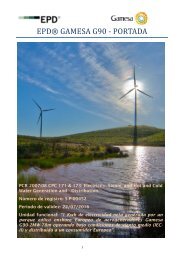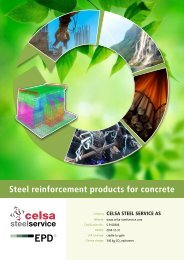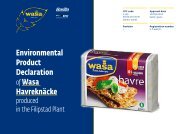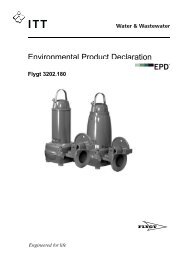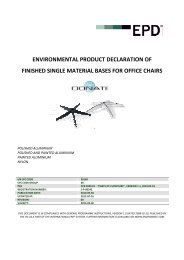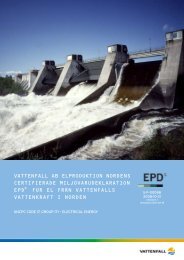Leather for clothing, upholstery, footwear, leather goods ...
Leather for clothing, upholstery, footwear, leather goods ...
Leather for clothing, upholstery, footwear, leather goods ...
- No tags were found...
You also want an ePaper? Increase the reach of your titles
YUMPU automatically turns print PDFs into web optimized ePapers that Google loves.
Product Environmental Declaration<strong>Leather</strong> <strong>for</strong><strong>clothing</strong>, <strong>upholstery</strong>,<strong>footwear</strong>, <strong>leather</strong> <strong>goods</strong>,accessories andinterior designVicenza TanneryDistrictProject financed and coordinated by theProvince of Vicenza – Giada AgencyInternational EPD® operated by The International EPD Consortium (IEC)CPC code: 2912 – Geographical application area: Europe, North America, Asia e North Africa<strong>Leather</strong> <strong>for</strong> <strong>clothing</strong>, <strong>upholstery</strong>, <strong>footwear</strong>, <strong>leather</strong> <strong>goods</strong>, accessories and interior designReference PCR: Product Category Rules – Finished Bovine <strong>Leather</strong> – Version 1.0_dated 2011-09-28VALIDATED PRODUCT ENVIRONMENTAL DECLARATION – REGISTRATION NUMBER: S-P-00344Approval date: 04/04/2012 - Review: 0
SUMMARY1 COMPANY INFORMATION......................................................................................22 PRODUCT INFORMATION.......................................................................................43 LCA STUDY ............................................................................................................53.1 Functional unit........................................................................................................ 53.2 Limits of the analysed system................................................................................. 53.3 Use of resources ..................................................................................................... 63.4 Potential environmental impact............................................................................. 73.5 Other indicators...................................................................................................... 73.6 Other in<strong>for</strong>mation................................................................................................... 83.7 Comparison of the EPD within this product category ............................................ 94 INFORMATION ABOUT THE COMPANY AND CERTIFICATION BOARD .........................94.1 Company contacts .................................................................................................. 94.2 Control process....................................................................................................... 94.3 EPD validity ............................................................................................................. 94.4 Expiry date .............................................................................................................. 95 BIBLIOGRAPHY ....................................................................................................106 GLOSSARY...........................................................................................................10
1 COMPANY INFORMATIONThe Dani Group came into existence in 1950 thanks to the initiative of Angelo Dani, who beganproducing <strong>leather</strong> <strong>for</strong> industrial glove manufacture. In the 80s company management was passedonto his children, who were responsible <strong>for</strong> the physical development, product range extension andgeographic expansion of the company, which culminated in the opening of two commercialorganisations in the USA and China. The company’s four factories are all in the Arzignano IndustrialZone, at: Via Quarta Strada, 20 – Via Quarta Strada, 16 – Via Quarta Strada, 9/11, Via della Concia,176.Dani <strong>leather</strong> is the result of a long production cycle that is entirely carried out in Arzignano, brokendown in the following three macro-phases:- From raw hide to wet blueDuring the riviera phase, the hide undergoes all the treatments in preparation <strong>for</strong> the tanningproducts: desalination and soaking, shaving, liming through to the mechanical operations ofstripping, trimming and splitting.The tanning agents are used in this preparatory phase, mainly chrome, which is followed by thepressing and selection processes, followed by preparation <strong>for</strong> dyeing (splitting and shaving). Thistanned hide is known as wet blue.- From wet blue to crustIn the retanning, dyeing and greasing phases the hide, stabilised by now, gains colour,consistency and softness of texture. It is then dried, which is programmed according to the finaluse, and staked to soften the fibres. This produces the crust <strong>leather</strong>.- From crust to finished <strong>leather</strong>This is the final ennobling phase, where a series of operations are alternated to give the <strong>leather</strong>the final appearance: pigment sprays, protective resins and waxes, stretching, embossing andfulling, which gives the <strong>leather</strong> the right degree of softness and shine.The finished <strong>leather</strong>s are selected one by one, measured and then addressed to the various markets,including furniture, <strong>footwear</strong>, <strong>clothing</strong> and <strong>leather</strong> <strong>goods</strong>.The Dani Group has always placed special focus on protecting the environment and a very carefuluse of the natural resources, and, consequently, considerable investments have been made inresearch projects to reduce all their polluting emissions.The Ecolife project, which involves constant interaction with our Research and DevelopmentDepartment and the Universities of Padua, Naples and Venice, was conceived to satisfy this need,and it comprises the following sub-projects:- Tanning without the use of heavy metals- Shaving without the use of sulphides- New logistics-production system <strong>for</strong> processing fresh hides- Defining the carbon footprint of the <strong>leather</strong>.This last project was implemented in 2011, which lead to receiving the Carbon Footprint of Product(CFP/02/2011) which calculates the impact of the <strong>leather</strong> on climate change, and indicates theamount of greenhouse gases that are given off during the lifecycle of the <strong>leather</strong>.GRUPPO DANI SPA – EPD® 2
The foundations had already been laid in 2009, when the Dani Group obtained the ProductEnvironmental Balance Sheet <strong>for</strong> certain furniture products, with other products later being certifiedin 2010.In 2012 the Environmental Management System will be developed in accordance with UNI EN ISO14001 standards.There is also the strong need to achieve more effective management of the social and ethical impactof the company, which will be implemented further to the introduction of a governance model <strong>for</strong>the company’s social responsibility.The Dani Group has obtained the following quality and environmental certifications:- Since 1997 the Dani Group is certified to ISO 9001 standards.- Since 2009 Dani <strong>leather</strong>s have been covered by two product certifications: UNI 11181 (ProductEnvironmental Balance Sheet) – UNI 11239 (<strong>Leather</strong> from Italy Full Cycle).- Since 2011 Dani <strong>leather</strong>s are accompanied by the Carbon Footprint of Product certificate, whichis verified by SGS in accordance with the ISO 14067/CD2 standard.GRUPPO DANI SPA – EPD® 3
2 PRODUCT INFORMATIONThe product covered by this declaration is “finished cowhide”, intended as a finished product by thetanning industry, ready to be used as a semi-processed input <strong>for</strong> the next trans<strong>for</strong>mation phases bythe various manufacturing industries. The hide can be used as a semi-processed product <strong>for</strong> variousfinished products, such as furniture, <strong>clothing</strong>, <strong>footwear</strong>, etc. As the use of “finished cowhide” variesconsiderably in the final consumer products, no specific product function is defined.This declaration is based on the average production of “finished cowhide” in the tannery during thereference period of 2009, and there<strong>for</strong>e the results do not refer to any specific category of <strong>leather</strong>.A raw hide could be considered a waste product from the slaughterhouse, and the tanning processescould be considered as a waste recovery process. In compliance with the conservative approach thatis requested by the PCR relative to this declaration, the raw hide is considered as a co-product ofcattle breeding, and there<strong>for</strong>e has an environmental impact relative to that phase as well.Material and chemical substances contained in finished cowhide (1 m 2 ):• Dermic tissue 75 %• Water 15 %• Chemical substances* 10 %*Trivalent Chromium, synthetic tanning, greasers, colorants, pigments, inorganic salts.Chemical substances contained in finished cowhide subject to legal limits:* Detection limitsA Germany, 18 th amendment of the LBGV, 3 rd August 2010B Japan Law 112 <strong>for</strong> the control of household products containing harmful substancesC Reg 1907/06/CE REACHDReg 1907/06/CE REACHSubstance Unit of measure Total Legal limitsChemical substances contained in the hideHexevalentchrome ppm None < 3 AFormaldehyde ppm < 5 < 75 BPentachlorophenol ppm < 5* < 5 CAzocolorants ppm None < 30 DGRUPPO DANI SPA – EPD® 4
3 LCA STUDY3.1 Functional unitThe functional unit is the production of 1 m 2 of “finished cowhide”, measured according to the ISO11646 standard.The product identification according to CPC (Central Product Classification) is “Other <strong>leather</strong>, ofbovine or equine animals, without hair on” - CPC 2912.3.2 Limits of the analysed systemThe following graph demonstrates the system limits:Gruppo Dani has 5 production plants that are located in Arzignano (Vi), via 4° Strada 20, via 4°Strada 9/11, via 4° Strada 16, via della Concia 176, via Sesta Strada 31.The three upstream, core and downstream modules must be reported separately as they refer to theuse of resources, potential environmental impact and other indicators, such as waste.GRUPPO DANI SPA – EPD® 5
For ease of understanding, the data are given in the following tables:3.3 Use of resourcesThe use of resources is given in the table by functional unit, and divided among the upstream, coreand downstream modulesFinished cowhide (1 m 2 )Environmental indicator Unit Total Upstream Core DownstreamMaterialsIncluding:gravelsodium chloridelimephosphatesulphurkg 4.64 1.06 3.33 0.25kg 2.32 0.10 1.98 0.23kg 0.88 0.43 0.45 0.00kg 0.54 0.02 0.52 0.01kg 0.44 0.44 0.00 0.00kg 0.12 0.00 0.12 0.00Unrenewableresourcesother kg 0.33 0.08 0.25 0.01EnergyIncluding:natural gasMJ 224.43 101.36 118.04 5.03MJ 86.42 45.66 40.70 0.06oil**kgMJ1.8773.570.8635.080.9234.450.094.05coal**kgMJ0.9014.660.084.630.809.860.020.18uraniumpropyleneotherMJ 5.14 0.30 4.62 0.22MJ 4.52 0.00 4.52 0.00MJ 40.10 15.68 23.90 0.52Raw hide kg 3.93 3.93 - -RenewableresourcesEnergyIncluding:BiomassWind, solar,geothermalMJ 5.06 0.38 4.61 0.08MJ 1.12 0.04 1.07 0.01MJ 0.19 0.01 0.18 0.00Otherwater MJ 3.75 0.33 3.36 0.07Water usage***Electricityusage****∗Not apllicable∗∗Coal and Oil are expressed in kg and in MJ∗∗∗ Of which internal water usage <strong>for</strong> production processes is 118.74 litres.∗∗∗∗Refers only to internal Energy usage <strong>for</strong> the production processesl 805.55 24.25 779.05 2.25KWh 2.80 n.a. * 2.80 n.a. *GRUPPO DANI SPA – EPD® 6
3.4 Potential environmental impactBelow are the potential environmental impact data by functional unit (F.U.) divided among theupstream, core and downstream modules (the data given in the table are taken from the LCA study).Finished cowhide (1 m 2 ) Upstream Core DownstreamImpact categoryGREENHOUSE EFFECT-GWP 100(kg CO 2 eq.)Total Agr./Breeding/Slaughter Production/Trans. Distribution54.99 47.75 6.93 0.31ACIDIFICATION (g SO 2 eq.) 431.32 393.08 36.79 1.45REDUCTION OF THE OZONELAYER (mg CFC-11 eq.)PHOTOCHEMICAL SMOG (gC 2 H 4 eq.)EUTROPHISATION (g PO 43-eq.)5.16 3.46 1.66 0.0422.09 15.45 6.22 0.42373.15 364.06 8.71 0.383.5 Other indicatorsThe other important indicators, again by functional unit and divided among upstream, core anddownstream, are given in the following table:Environmental indicator Unit Total Upstream Core DownstreamHarmful g 12.76 n.a. * 12.76 n.a. *WasteHarmless g 1,094.50 n.a. * 1,094.50 n.a. *Recyclablematerials- g 2,460.20 n.a. * 2,460.20 n.a. *Emissions (air)Of which:NH3kg 14.57 7.88 6.36 0.33kg 0.22 0.22 0.00 0.00NOxSOVSOxkg 0.16 0.14 0.02 0.00kg 0.05 0.00 0.05 0.00Kg 0.04 0.01 0.03 0.00Other kg 14.10 7.51 6.27 0.32OtherEmissions (water)of whichCOD filteredChloridesSulphateskg 3.90 2.72 1.17 0.01kg 0.03 - 0.03 -kg 0.47 0.03 0.44 -kg 0.36 0.01 0.35 -Others kg 3.05 2.68 0.36 0.01Chrome III ** g 83.16 n.a. * 83.16 n.a. *Formaldehyde** g 31.00 n.a. * 31.00 n.a. **Not applicable**Data referred to the chemical product usage in the processGRUPPO DANI SPA – EPD® 7
Other harmful chemical substances used in the CORE process Unit TotalCalcium hydroxide g 135.06Formic acid g 61.50Sodium sulphide g 60.35Sulphuric acid …% g 42.341-methoxy-2-propanol/Propylene glycol monomethylether g 40.88Sodium carbonate g 34.71Sulphites g 25.553.6 Other in<strong>for</strong>mationThe average thickness, pondered according to the measured finished product produced in thereference period, is 1.53 mm.Thickness classes:- [0-1) = 1%- [1-1.5) = 53%- [1.5-2) = 33%- [2-2.5) = 7%- [2.5-3) = 5%- [3-4+) = 2%97.9 % of the raw hides come from Europe, there<strong>for</strong>e from intensive breeding farms, and theremaining 2.1% from the USA, there<strong>for</strong>e from extensive farms.The average distance the finished <strong>leather</strong> travels from the tannery to the client’s gate is 958 km.For electricity the country mix data have been applied to Italy, using the “Electricity, medium voltage,production IT, at grid/IT U” process from Ecoinvent 2.2.The PCR is referred to <strong>for</strong> the cut-off criteria applied to the chemical products.Specifically speaking, with the active substance and average percentage the following is considered:1. Mixtures that do not contain harmful substances, with total mass consumption ≥ 1.5 % ofthe overall weight of chemical products consumed in the reference year.2. Mixtures containing one or more harmful substances, that are classified as harmful <strong>for</strong> theenvironment, mutagenic or carcinogenic, with total mass consumption ≥ 0.01 % of theoverall weight of chemical products consumed in the reference year.3. Mixtures containing one or more harmful substances that are classified as harmful <strong>for</strong> all theother types of risk, which are not indicated in paragraph 2), with total mass consumption ≥0.05 % of the overall weight of chemical products consumed in the reference year.The mixtures that are excluded from these cut-off criteria are grouped together, summing theamounts of harmful and non-harmful mixtures with those of the two respective mixtures that aremost consumed in their phases, as indicated in the PCR.GRUPPO DANI SPA – EPD® 8
3.7 Comparison of the EPD within this product categoryIt must be remembered that EPDs developed according to different programmes, are notcomparable.4 INFORMATION ABOUT THE COMPANY AND CERTIFICATION BOARD4.1 Company contactsThe Cycle Assessment (LCA) and this EPD were conducted by Guido Zilli and Tommaso Bissoli,employees of Gruppo Dani Spa, in cooperation with the Giada Agency of the Province of Vicenza andAequilibria di Pernigotti Daniele.The company contacts are:Guido Zilli – Quality Manager – email: guido_zilli@gruppodani.itGruppo Dani SpA – via Quarta Strada, 20 Z.I. Arzignano – Tel. 0444 471211 – www.gruppodani.it4.2 Control processPCR review conducted by:Independent control of the declaration anddata in accordance with the ISO 14025standard:Aequilibria di Pernigotti Daniele. email address:dpernigotti@aequilibria.comICEC , Istituto di Certificazione per l’area pelle.Via Brisa 3, 20123 Milano. Site: www.icec.itTel. 02.8807714.3 EPD validityThe EPD is valid <strong>for</strong> 3 years.4.4 Expiry dateGRUPPO DANI SPA – EPD® 9
5 BIBLIOGRAPHY Rapporto di LCA della pelle bovina finita del 9 dicembre 2011 – Gruppo Dani Spa Rapporto di Carbon Footprint di prodotto del 7 giugno 2011 – Gruppo Dani Spa Product Category Rules – Finished Bovine <strong>Leather</strong> – Version 1.0_dated 2011-09-28 Database: Ecoinvent 2.2; Buwal 250; LCAfood Industry data. Cradle-to-Gate Environmental Assessment of Enzyme Products Produced Industrially in Denmarkby Novozymes A/S; Per H. Nielsen et al.; Int J LCA 2006 (OnlineFirst): 7 Rapporto ambientale UNIC 20096 GLOSSARY Acidification: lowering the pH level in soil, lakes, <strong>for</strong>ests, caused by emissions into theatmosphere of acid substances, with subsequent damage to living organisms (e.g. “acid rain” ). Greenhouse effect (GWP 100): a global heating phenomenon of the atmosphere, calculated <strong>for</strong>the next 100 years, due to emissions into the atmosphere of greenhouse effect gases, such ascarbon dioxide (CO 2 ), methane (CH 4 ), nitrous oxide (N 2 O), etc. Eutrophication: reduction of the oxygen level in the water, which is necessary <strong>for</strong> theecosystems, cause of excessive deposits of nutrients such as nitrogen and phosphorous. Reduction of the ozone layer: degradation of the stratospheric ozone layer, which is a protectivebarrier against ultraviolet sunrays, due to particularly reactive substances which are <strong>for</strong>med fromchlorofluorocarbons (CFC) or chlorofluoromethanes (CFM). The reference substance used <strong>for</strong> theODP (Ozone Depletion Potential) is trichlorofluoromethane, or CFC-11. Formation of photochemical smog: <strong>for</strong>mation of ozone on the earth surface level due toemissions into the atmosphere of unburnt hydrocarbons and nitrous oxide due to sun radiation.This phenomenon is damaging <strong>for</strong> living organisms and is often found in large urban centres. Wet blue: wet <strong>leather</strong> after chrome tanning (intermediate process phase). Crust: tanned, greased and dried <strong>leather</strong>, ready <strong>for</strong> finishing.GRUPPO DANI SPA – EPD® 10
Gruppo Dani S.p.a.Via 4 a Strada, 20 - Z.I.36071 Arzignano (VI) - ItalyPh. + 39 0444 471211Fax. + 39 0444 450839info@gruppodani.itwww.gruppodani.it


